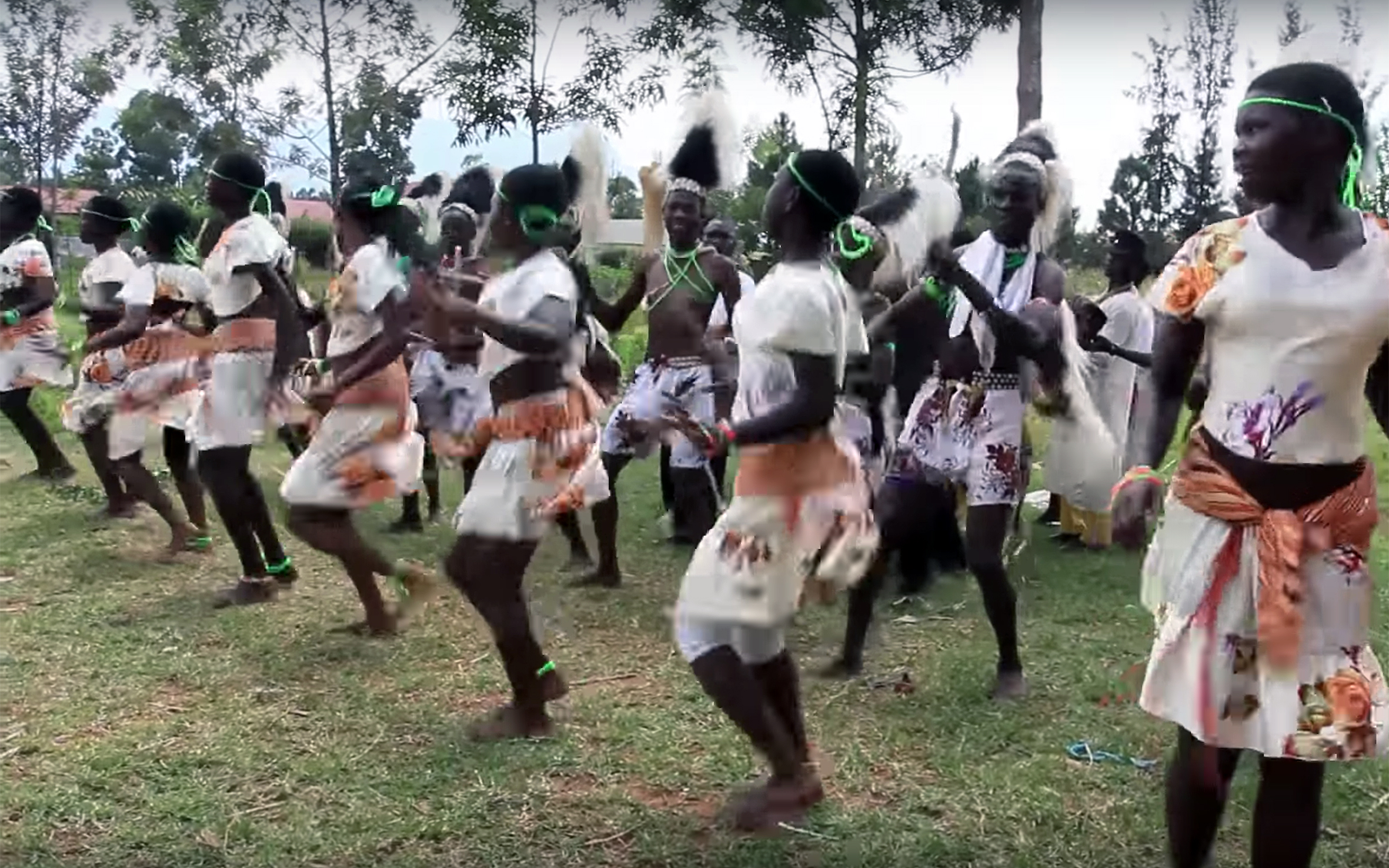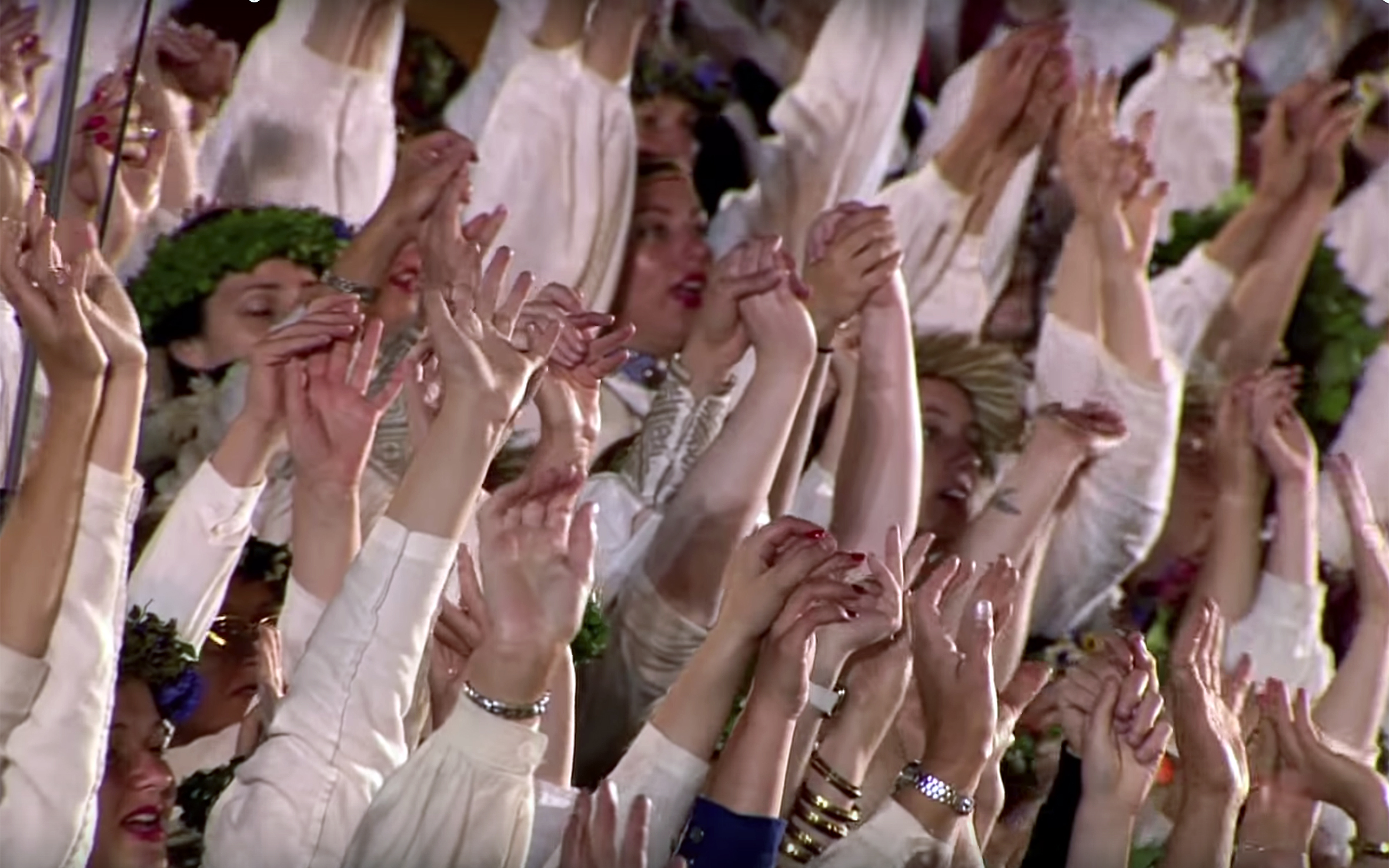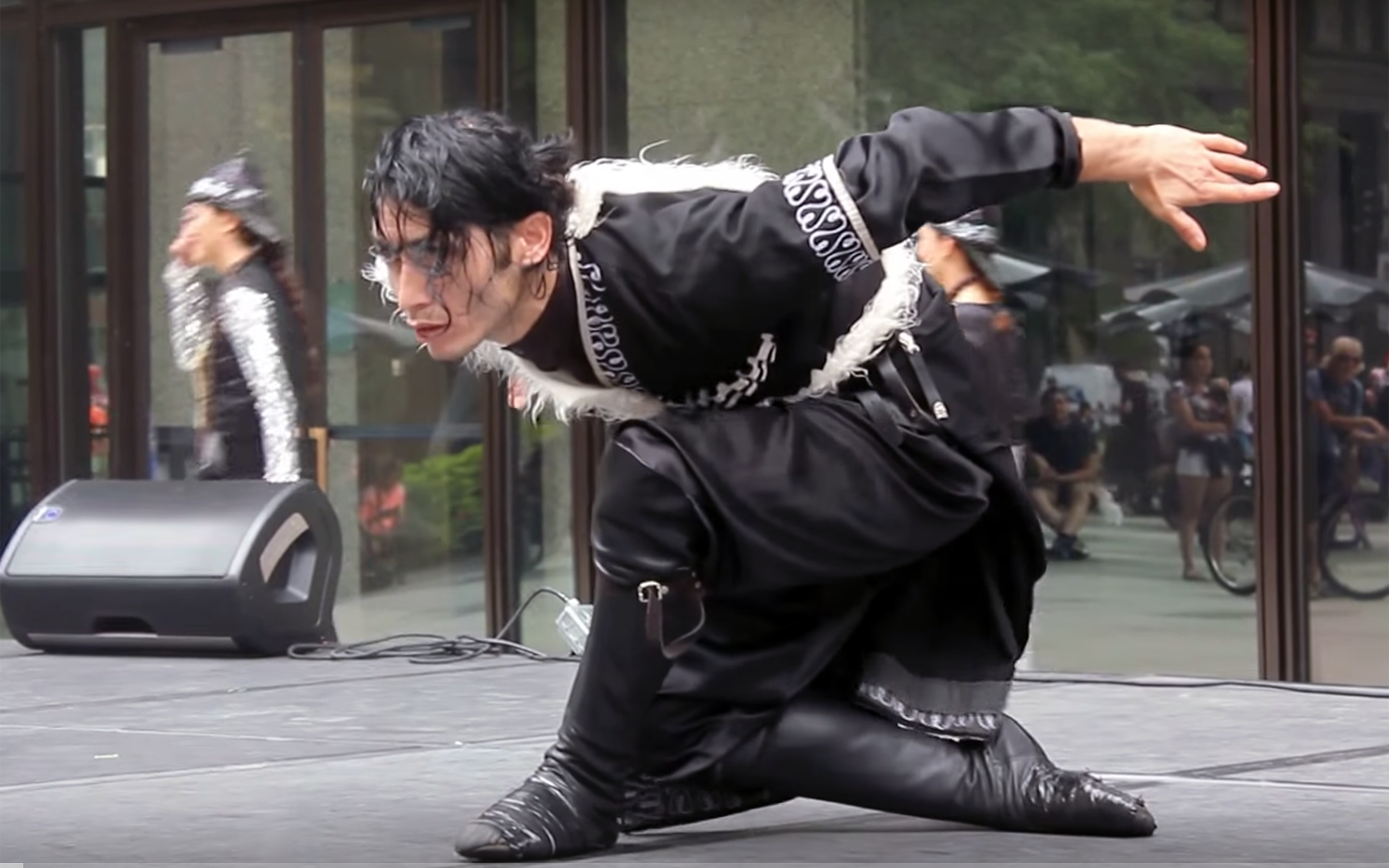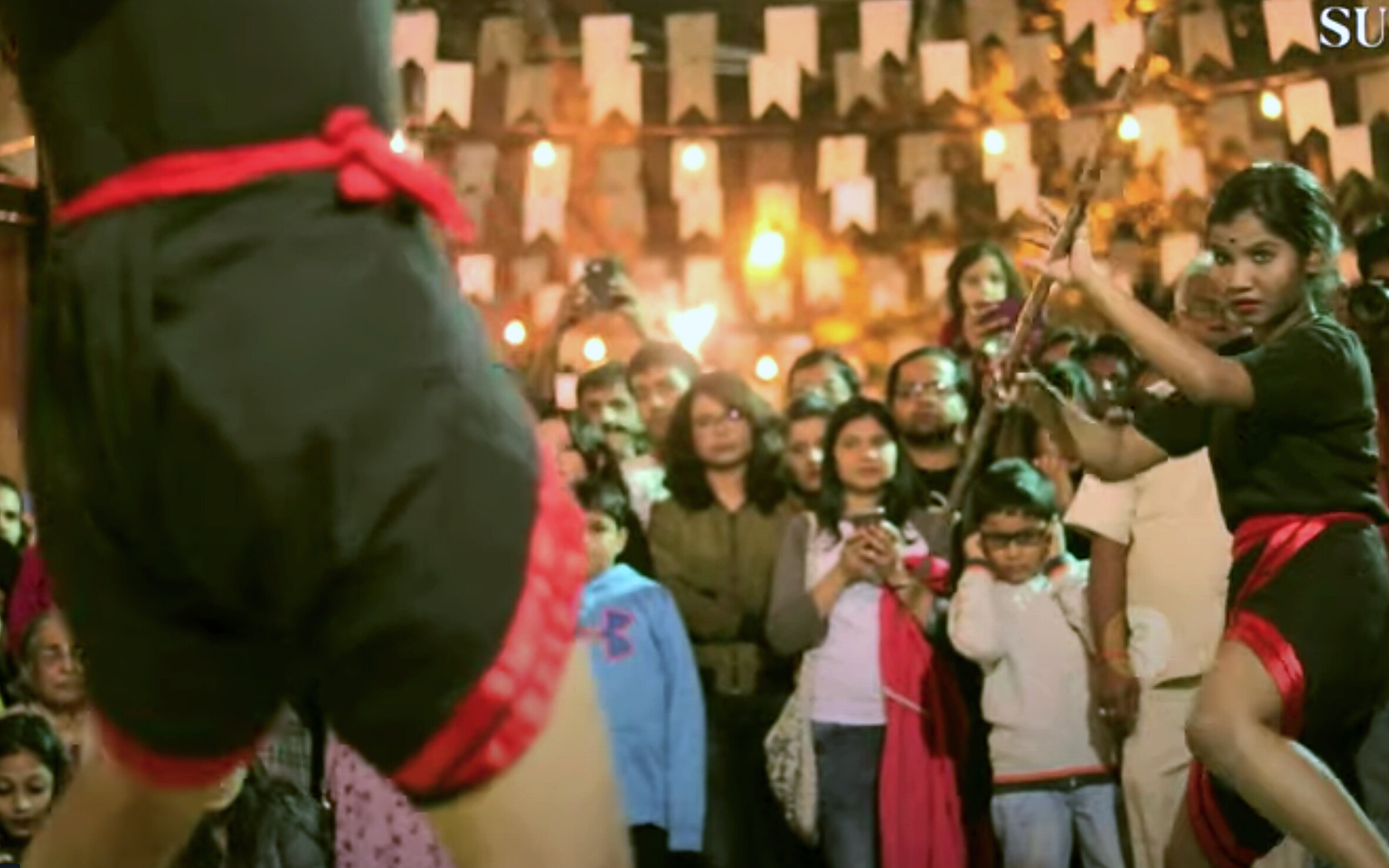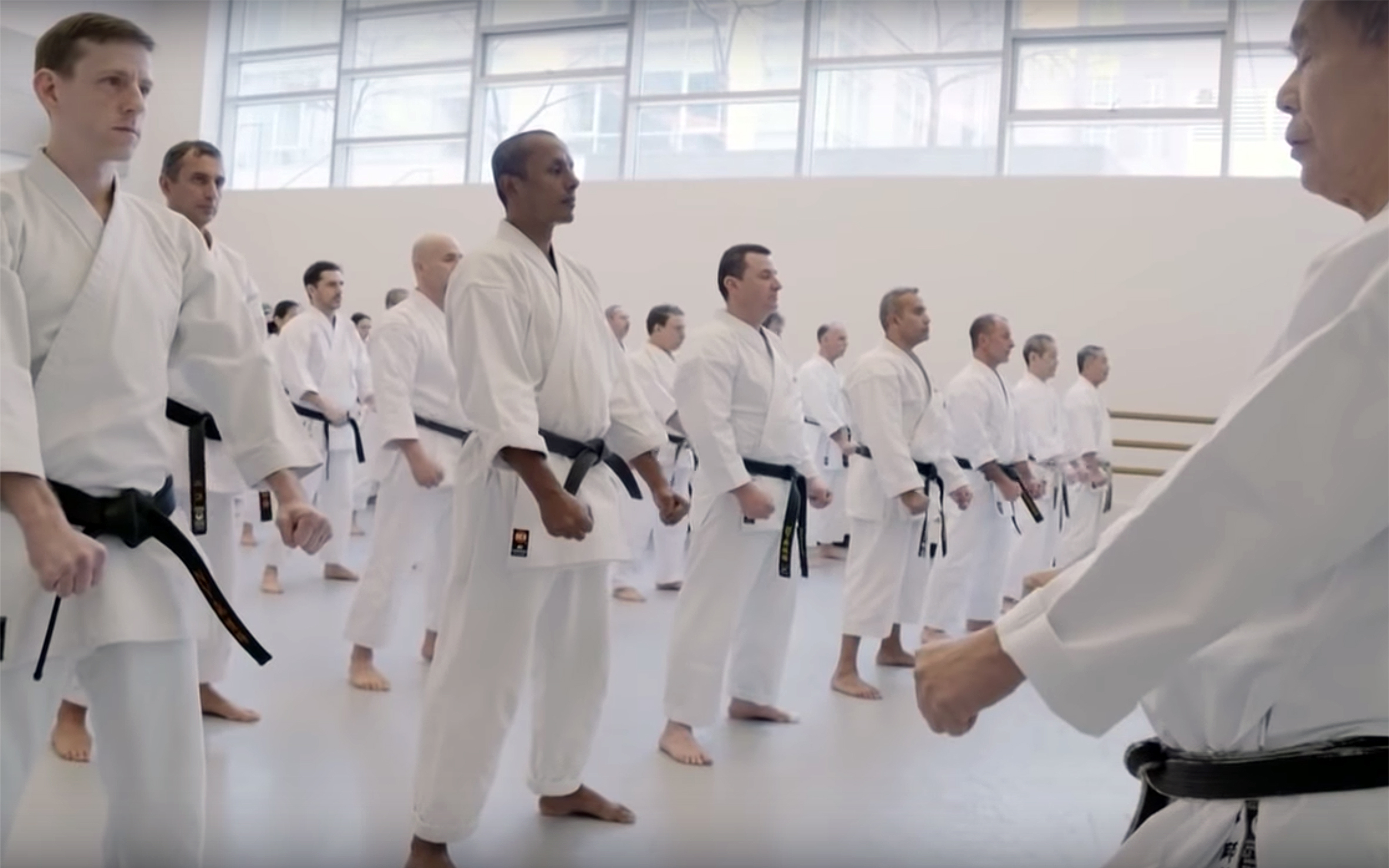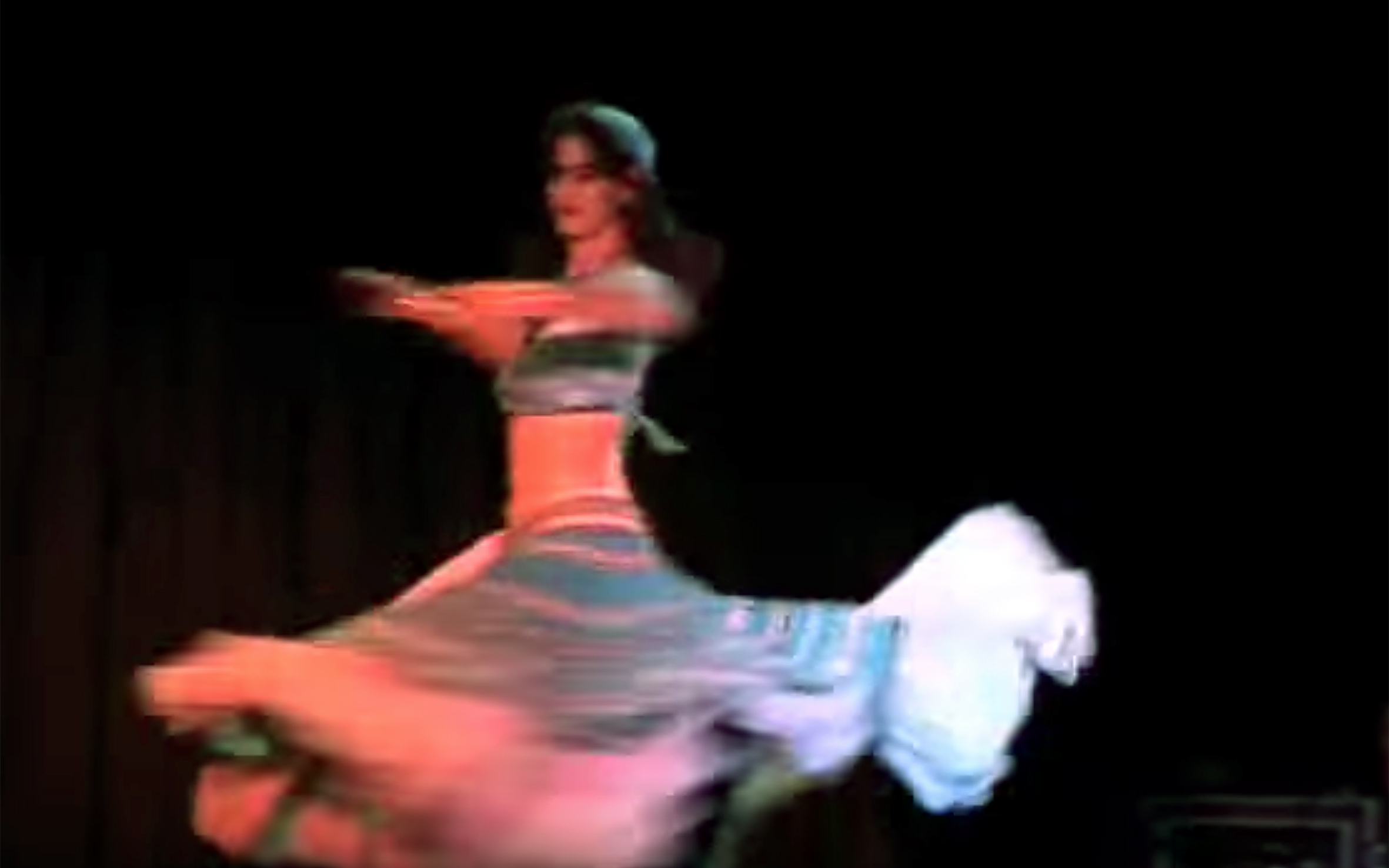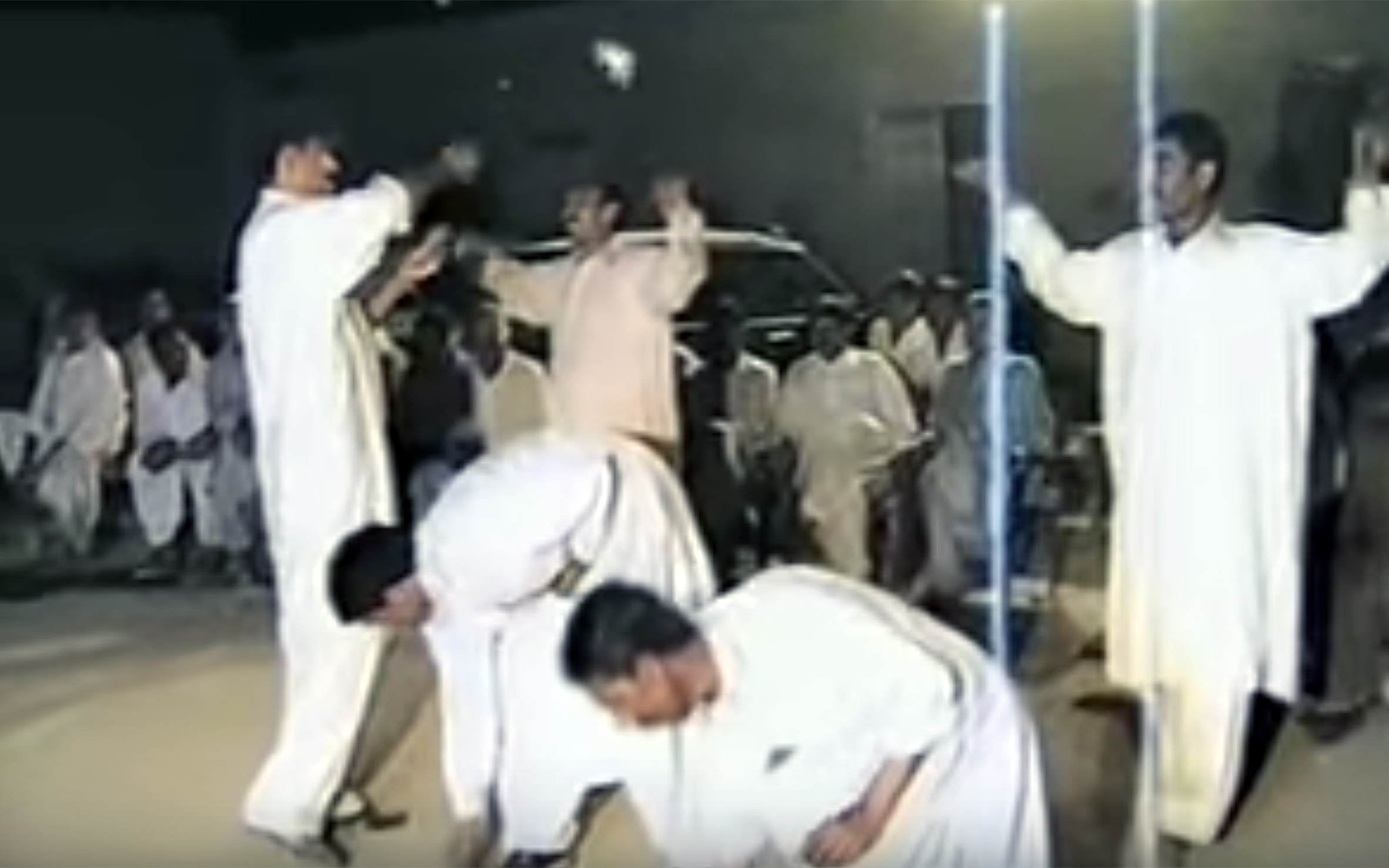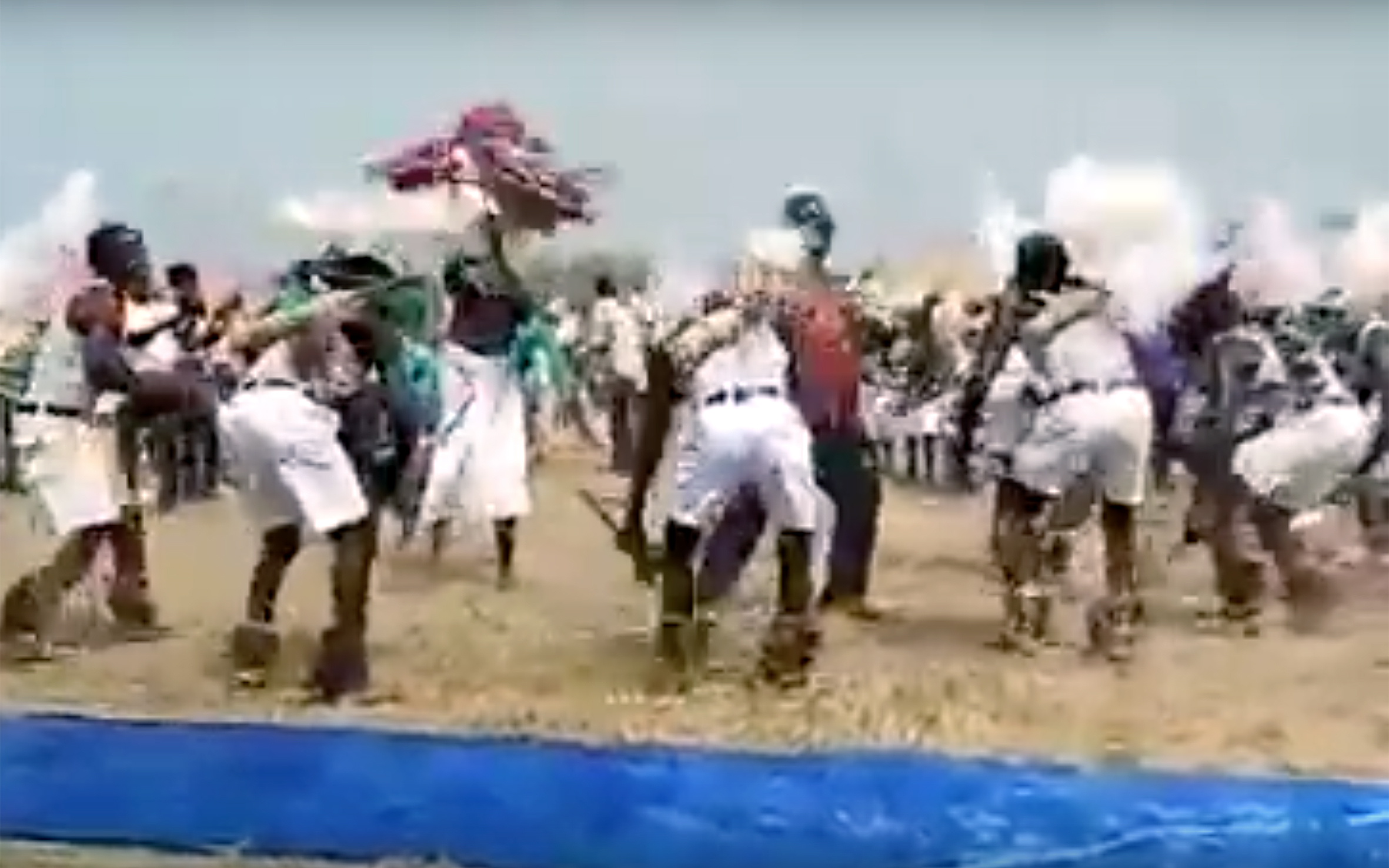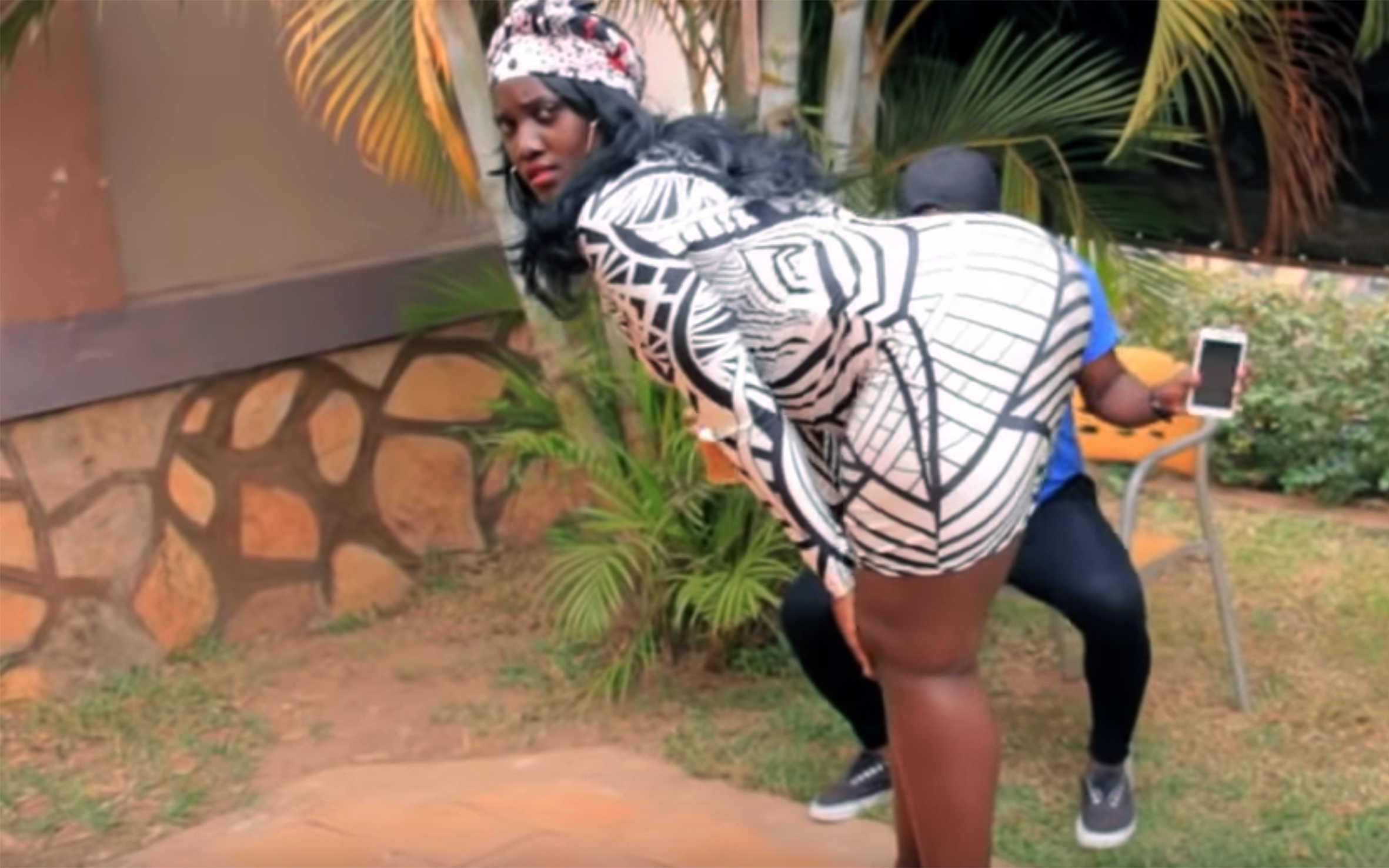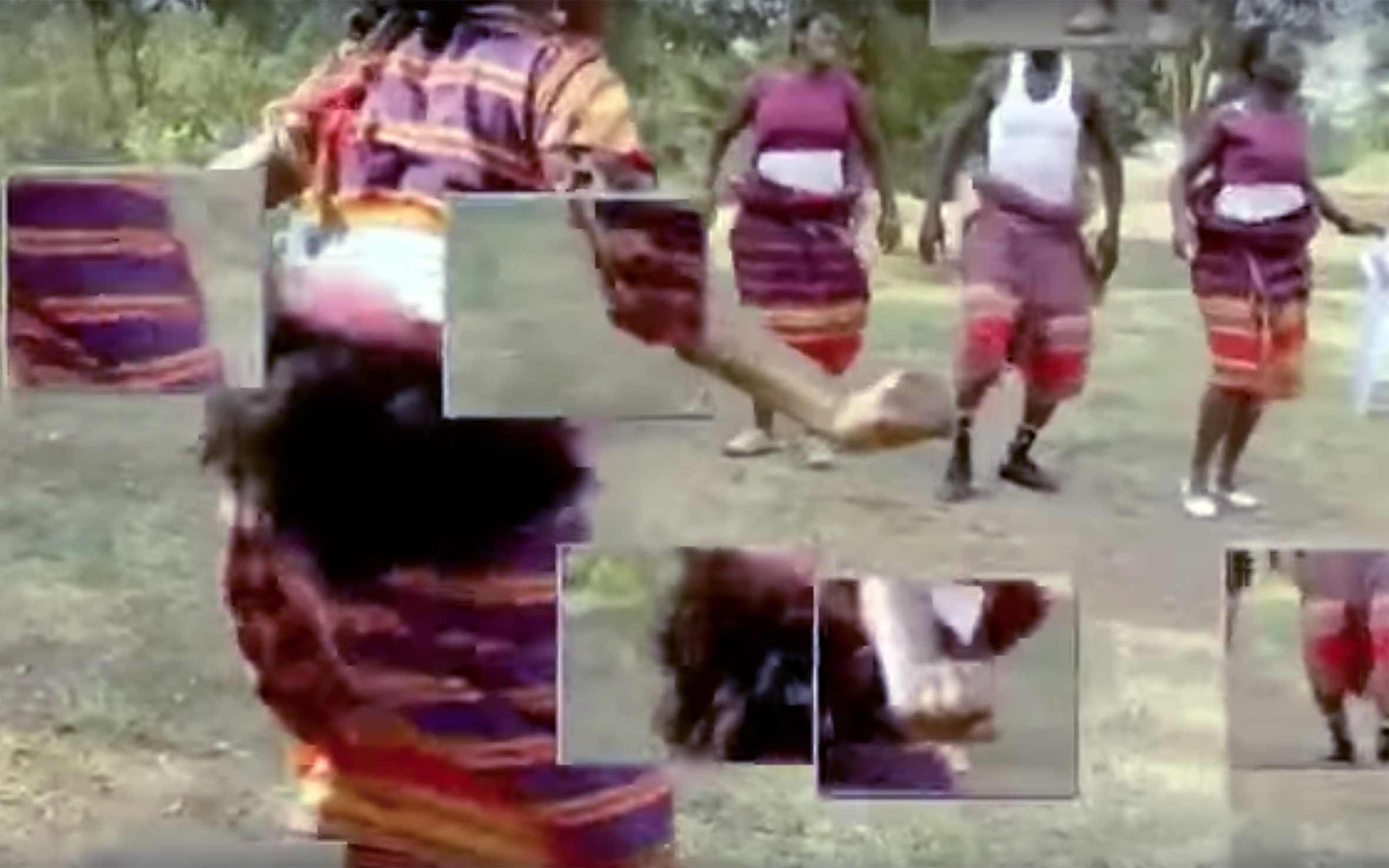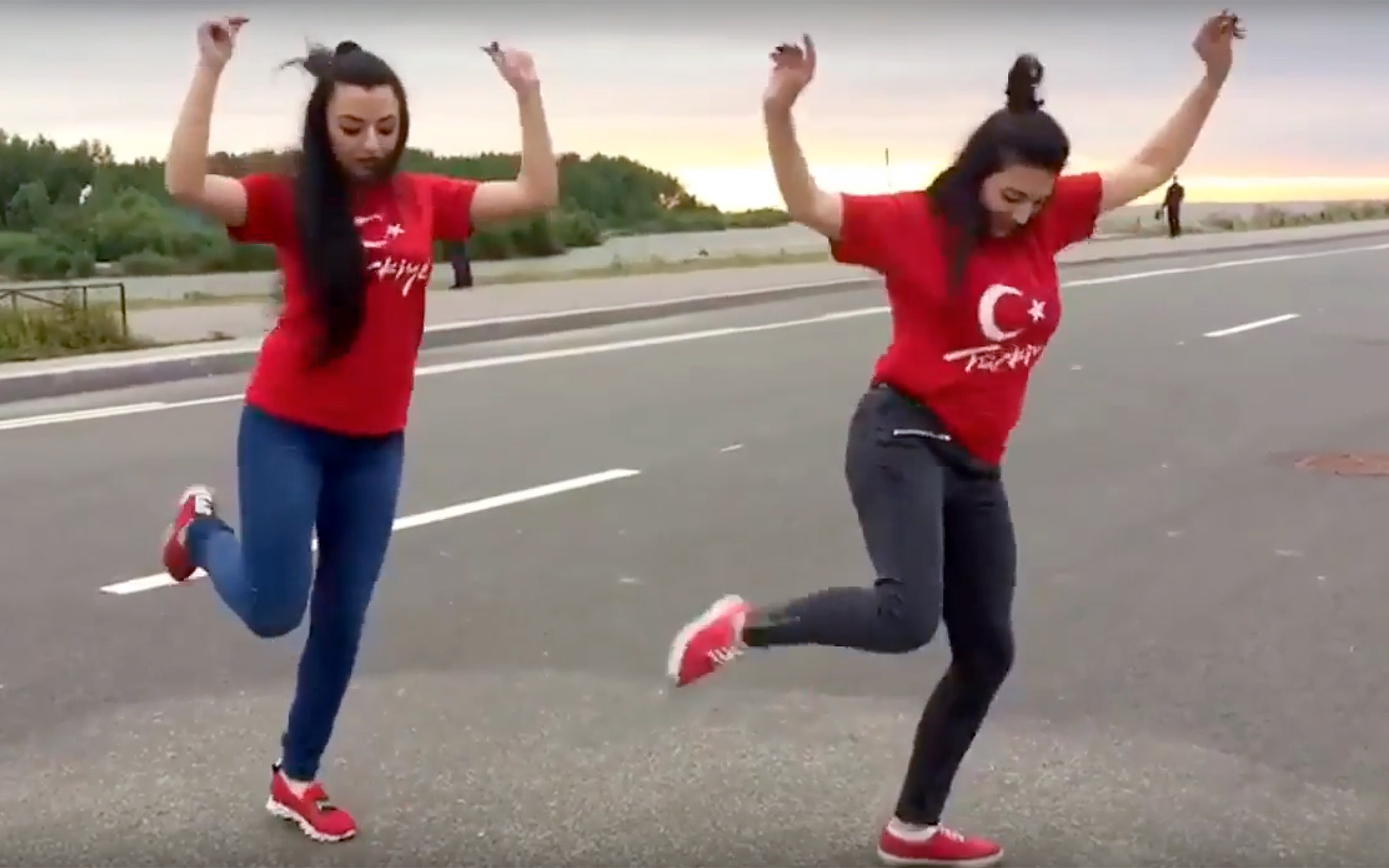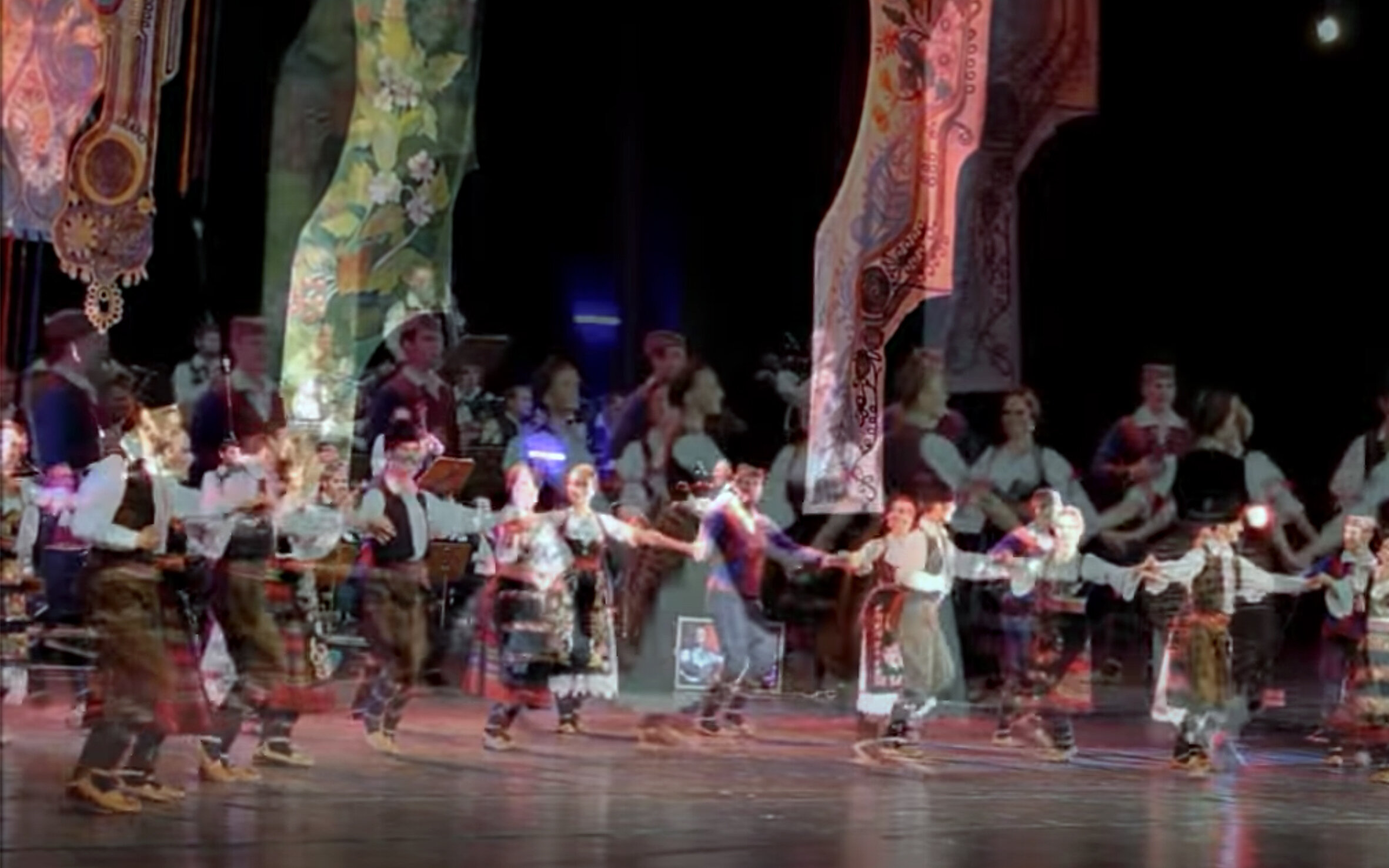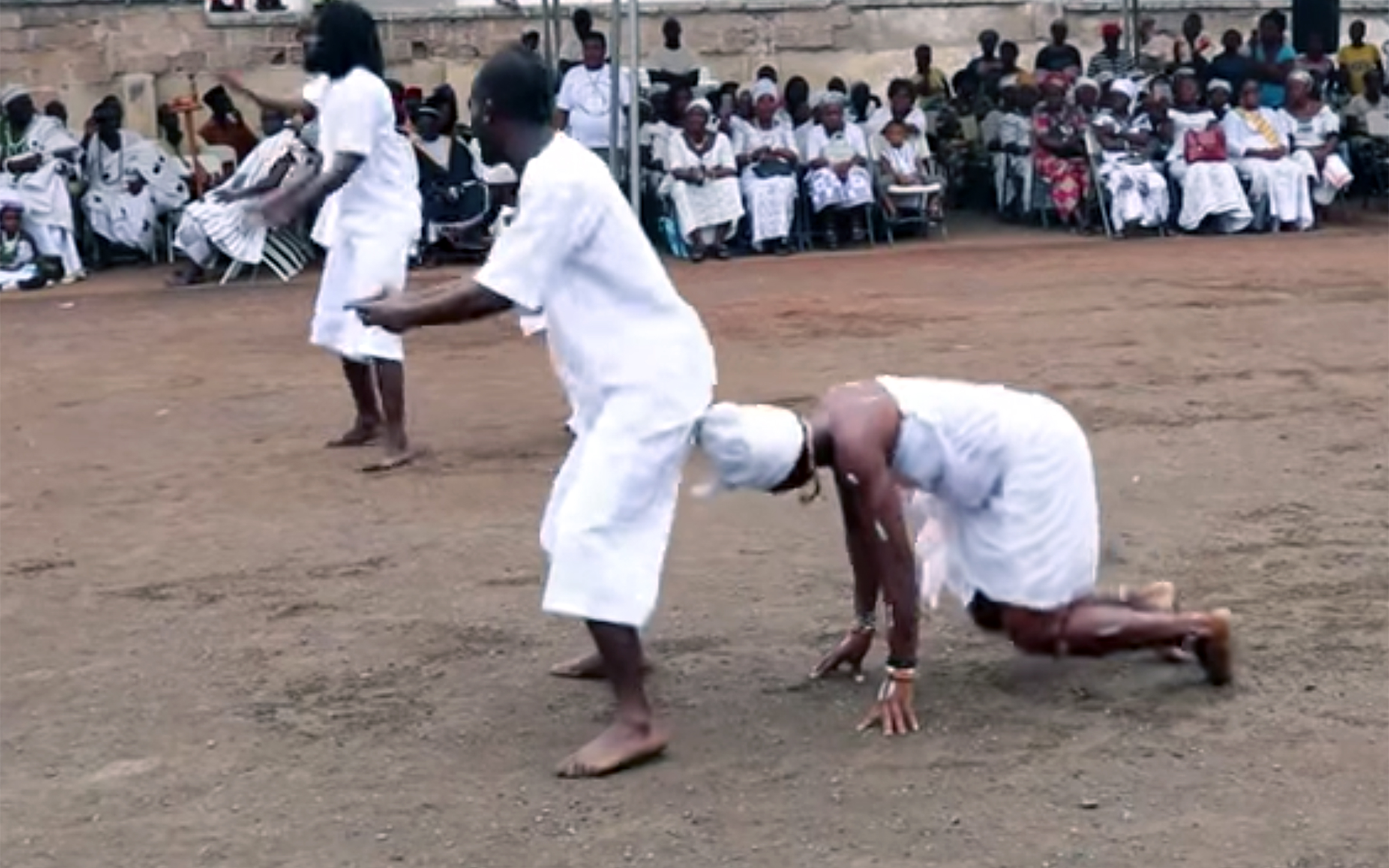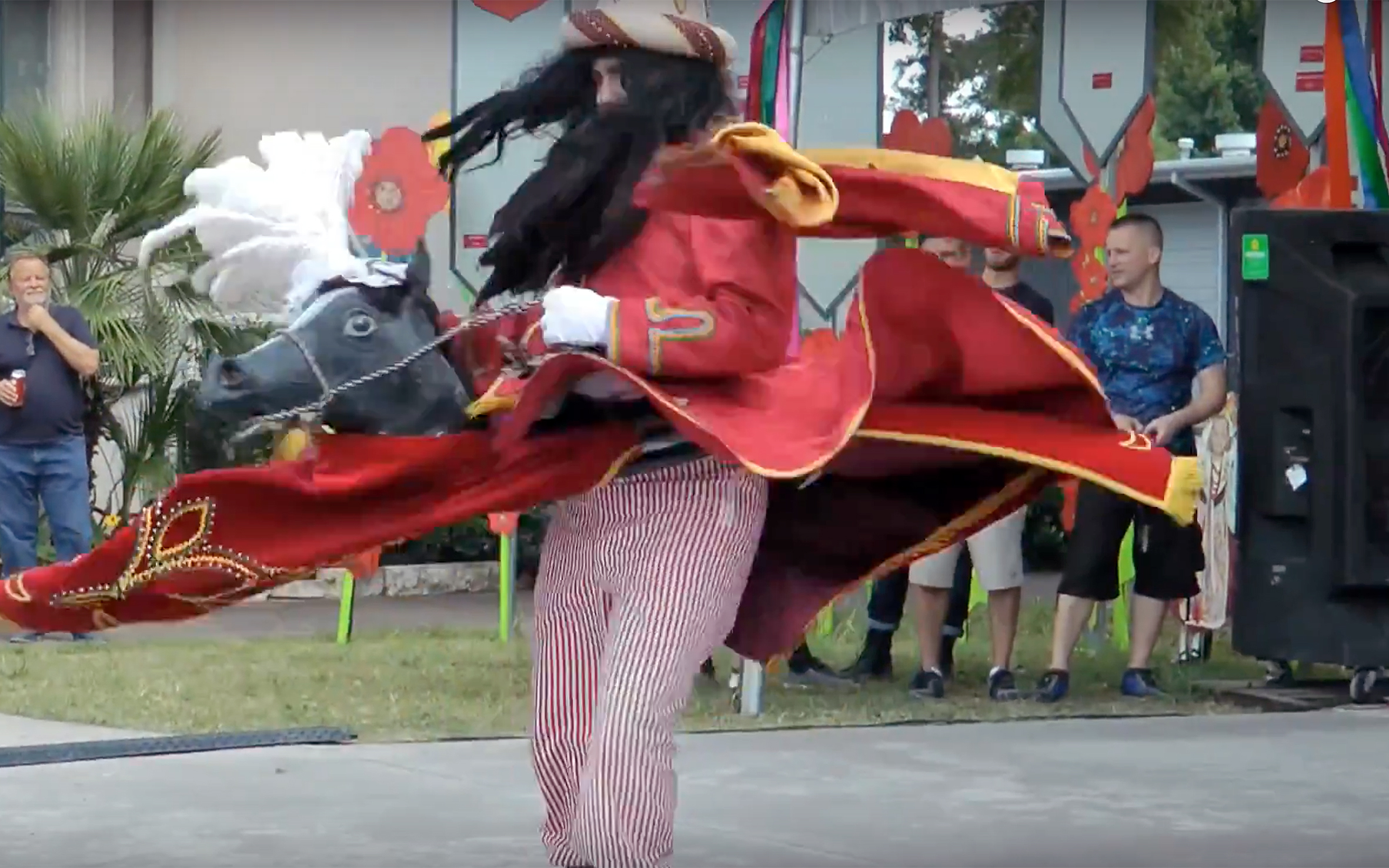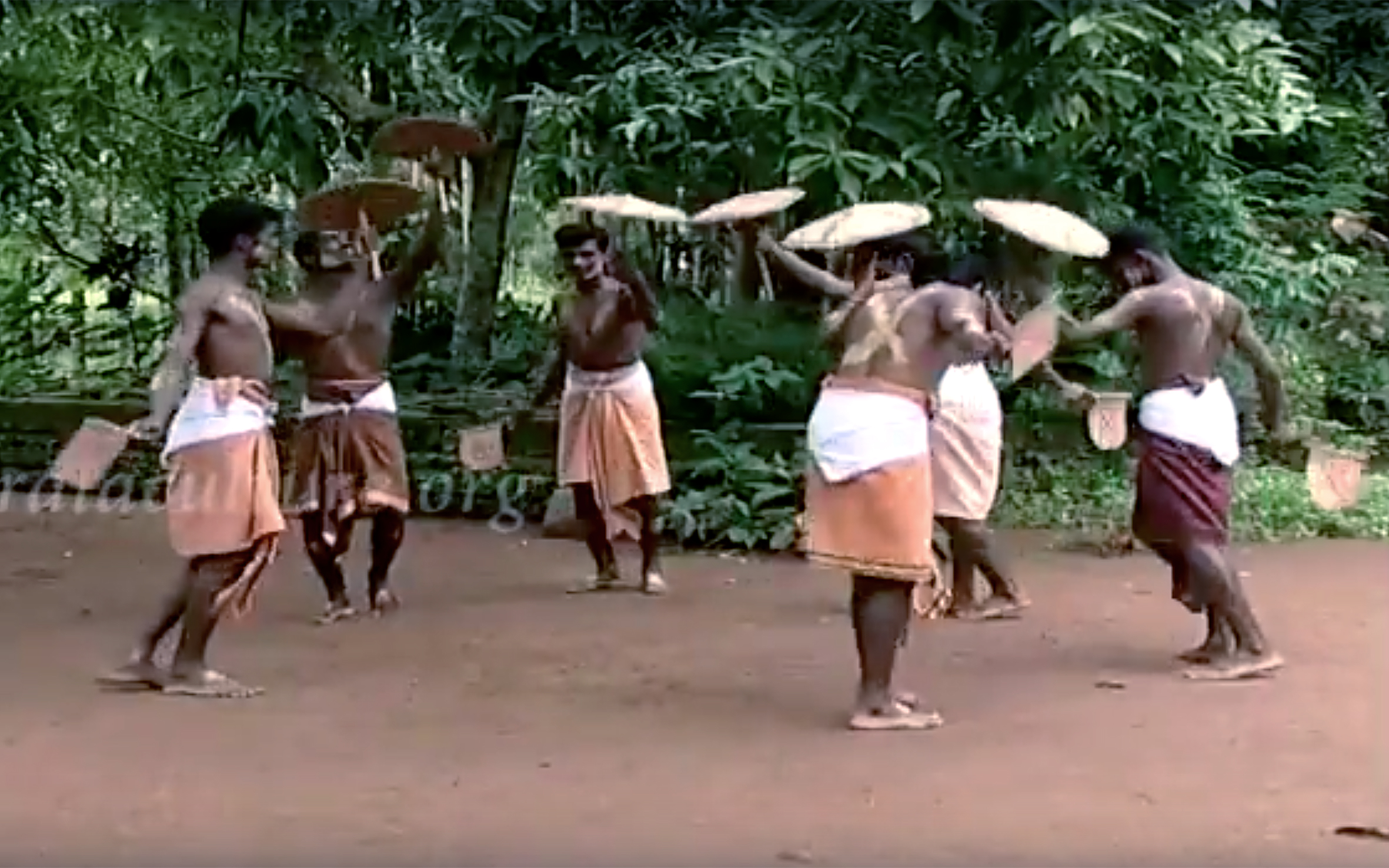435.Kaâda / Morocco
KAÂDA is a Moroccan tap dance, performed mostly, but not exclusively by men, with a band playing music and the dancer tapping a back and forth “conversation” with the musicians.
436.Kacchi Ghodi / India
KACCHI GHODI is an Indian folk dance that originated in the Shekhawati region of Rajasthan. It has since been adopted and performed throughout the rest of the country. Dancers wear novelty horse costumes, and participate in mock fights, while a singer narrates folk tales about local bandits. It is commonly performed during wedding ceremonies to welcome and entertain the bridegroom’s party, and during other social events.
437.Kadodi DANCE / Uganda
KADODI is a Gisu traditional freestyle dance from Uganda, typically performed at the Gisu male circumcision initiation ceremony, the Imbalu. Its beat sends pulsating waves through all that encounter its rhythm leaving no one the same. The dance is not intimidating and is largely participatory, with the audience free-styling as the beat leads them. In a country where hundreds of cultures abound, Kadodi stands unchallenged and continues to conquer hearts wherever it is introduced.
438.Kad tie zeni prūšos gājā / Latvia
KAD TIE ZENI PRŪŠOS GĀJĀ (“When those men to Prussia went”) is a decoratively dramatic Latvian dance, for the middle aged dance groups. The idea is to break with a misunderstood concept of a “wild sea wolf”, when he is away from home. The sailor remains faithful to proven values—his wife. The dance follows folk song lyrics with its inside dramaturgy. It is danced energetically and with humor.
439.Kafkas / Turkey
KAFKAS is a dance from the northeastern part of Turkey. It is performed by both men and women. The dance is characterized by speed, agility, and the ability to manoeuvre the body in tune with the increasing speed of the music. It shows societal beliefs and customs, and other aspects of life such as love, peace, honour, jealousy and bravery.
440.Kai Silambu Attam / India
KAI SILAMBU ATTAM is performed in temples of Tamil Nadu in India during the Amman or Navaratri festival. The dancers wear ankle-bells and silambu on their hands, which make noise when shaken. They perform various steps and jumps. The dance praises all female deities, in particular the powerful angry goddess—Kali or Durga.
441.Kaikottikali / India
KAIKOTTIKALI is a South Indian dance from the Hindu communities of the state of Kerala, India. It is performed exclusively by women mainly during the Malayalam festival of Onam and during the Thiruvathira day that usually falls between December and January, or any other festive occasion. The unmarried young girls believe that the Kaikottikali dance will bring them luck in marriage and a happy married life. Kaikottikali dance is believed to have been developed out of the classical Kathakali dance of Kerala. It involves a dance area and in its centre a ceremonial brass light known as the Nilavilakku is placed, over a traditional flower decoration called the Pookalam. Around this centre the women and young girls arrange themselves in concentric circles and start dancing in a circular motion to the beat of their clapping and meter of their singing.
442.kaka DANCE / Sierra Leone
KAKA DANCE is a dance of a Kaka devil performed by the Kaka masker who sings in accompaniment to his own dance, which makes it clear that this devil is a dressed up human. Dancing devil ceremonies are very common in Sierra Leone because of the different types of devil beliefs. Some devils are referred to as spirits and some are believed to help for example in times of wars. These types of dances are used to entertain during ceremonies and to educate people about local culture.
443.Kalanga Dihosana / Botswana
KALANGA DIHOSANA is a traditional rain making dance by the Kalanga or Ikalanga people in Botswana, which has been performed for a long time. It involves the invitation of ancestors through a trance to pray for rain. The dancers usually dance in groups and wear black skirts, and long strings of beads in their necks. Dihosana is part of the Kalanga culture and not everyone qualifies to be a Dihosana dancer.
444.Kalaripayattu / India
KALARIPAYATTU is a martial art and fighting system, which originated as a style in North Kerala in India. The word “kalari” first appears in Tamil Sangam literature. It is considered to be one of the oldest surviving fighting systems still in existence in the world. Although originally practiced in Kerala, it is also practised in the southern parts of Tamil Nadu. It is sometimes performed on a stage as a dance form.
445.Kalbelia / India
KALBELIA is one of the most sensuous dance forms, performed by a tribe of the same name in Rajasthan, India. The Kalbelias were known in ancient times for their frequent movement from one place to another. Traditionally, they were catching snakes and trading snake venom. Their dance movements and costumes bear a resemblance to that of the serpents. The dancers are women in flowing black skirts—they dance and swirl, imitating the movements of a serpent. The male performers play music. The dancers are tattooed traditionally and wear jewellery and garments richly embroidered with small mirrors and silver thread. As the performance progresses, the rhythm becomes faster and faster and so does the dance.
446.Kali amman / India
KALI AMMAN is a dance usually performed in different parts of southern India, where a dancer dresses up as Kali, the goddess of destruction, wearing a huge mask and performs at different Kali amman festivals at temples.
447.Kalinda / Trinidad and Tobago
KALINDA is a traditional stick-fighting dance that is practiced during Trinidad carnivals. It originated in the 19th century and involves two dancers who pretend to fight and joust with their sticks. They are accompanied by a drummer and a singer called “chantwell”. The chantwell’s main purpose is to talk trash to the opposing dancer/fighter. Kalinda is also a form of martial arts and is practiced in many countries around the world.
448.Kállai kettős / Hungary
KÁLLAI KETTŐS, also referred to in English as KÁLLÓ TWO-STEP, is an early vocal composition and a dance by Hungarian composer György Ligeti. It was composed in 1950 and is one of Ligeti’s collections of Hungarian pieces which the composer himself conceived as a whole. This composition was written, when Ligeti was still living in Hungary. He was very interested in adapting and arranging Hungarian traditional music with his own style. During this period, Hungary was going through the repressive Stalinist era.
449.Kamandi / India
KAMANDI is a popular folk dance belonging to the southern Indian state of Tamil Nadu. It is celebrated to commemorate the puranic event when Manmada—the god of love—was burnt to ashes by Lord Shiva in anger. Villagers separate themselves into two parties as Erintha katchi and Eriyatha katchi and a heated debate ensues about the fate of Manmada or Kamadev in this tale from the Purana. Kaman and Rathi, his consort, are the main characters.
450.Kamba dance / Kenya
KAMBA DANCE is undoubtedly the most spectacular manifestation of the traditional Kamba culture from Kenya, performed to throbbing polyrhythmic drum beats. It is characterized by exceptionally acrobatic leaps and somersaults, which flung dancers into the air. The style of playing was similar to that of the equally disappeared traditions of the Embu and Chuka: the drummers would hold the long drums between their legs, and would also dance.
451.Kambala / Sudan
KAMBALA is a dance found in the Nuba Mountains area in South Kordofan State in Sudan. This traditional and ceremonial dance has been passed on from one generation to another. The dancers imitate movements of cows. Kambala is associated with a myth that a farmer in the area of Nuba Mountains heard a mysterious voice calling on him to slaughter a bull and then tie its horns to his head. During the harvest season, people invited by farmers say that they can’t eat from the new harvested crop unless they perform Kambala. Nowadays Kambala is a popular dance—one of the main national dances that are performed on special occasions. It has been performed outside Sudan as well.
452.Kanchendzonga Dance / India
KANCHENDZONGA also called SINGHI CHHAM is a dance form in Sikkim, India, where the dancers perform in costume of the snow lion. It is a dance of the Bhutia people, usually performed during the Panglapsool festival. There may be two to four snow lions during the dance, with each snow lion consisting of two men in a white costume with a bluish mane. The dance is accompanied by a single drummer. It has religious connections as the peaks of Kanchenjunga, which is sacred to the people of Sikkim, are believed to resemble the legendary snow lion.
453. KANDYAN / Sri Lanka
KANDYAN are various dance forms native to the area called Kandy of the central hills region in Sri Lanka, nowadays also widespread to other parts of the country. Kandyan dances were traditionally performed only by male dancers. The technique, partly derived from South India, focuses on dynamism, powerful footwork, leaps and whirls. They have a vast repertoire, partly originating from an ancient indigenous ritual dance. Kandyan dances are now probably the most important cultural export of Sri Lanka. However, the most spectacular performances can still be seen in a religious context, particularly during the annual Kandy Perahera procession in the city of Kandy.
454.Karagattam / India
KARAGATTAM is a Tamil folk dance performed in honor and praise of the rain goddess Mariamman. In this beautiful folk dance, the performers use a water pot, clay or metal pots or other objects, which they balance on their heads. The pots are decorated in various ways and often topped with a moving paper parrot, which rotates as the dancer swings. Traditionally, this dance has two versions: Aatta Karakam symbolizing joy and happiness and performed mainly for entertainment; and Sakthi Karakam performed only in temples as a spiritual offering.
455.Kara Jorga / Kyrgyzstan / Kazakhstan
KARA JORGA is a popular rhythmic group dance, resembling the horse gallop, fast, but full of grace and delicacy. A horse plays an important role in the life of nomadic peoples, thus the dance imitates the movements of a man sitting in a saddle. It is danced by both men and women at a fast tempo. Kara Jorga is claimed by both Kazakhs and Kyrgyz, considering it their national dance and believed to have been brought to Kazakhstan by ethnic Kazakh repatriates from China. Some claim that it is foreign to the Kazakhs and in no way refers to their traditions. Regardless, the Kyrgyz have begun to practice this dance and it became iconic. Recently, Kara Jorga has been gaining popularity in other countries. People from China, the U.S., Malaysia, and Europe go crazy for it, performing it in colorful flash mobs and uploading dance videos to YouTube.
456.Karamajongo DANCES / Uganda
KARAMAJONGO DANCES are dances performed by the Karamajongo people, Nilotic-speaking agro-pastoral herders of the Ateker ethnic group living mainly in the north-east of Uganda, precisely in the Karamoja region.
457.KARATE / Japan
KARATE is a martial art developed in the Ryukyu Kingdom, Okinawa Prefecture in Japan. It developed from the indigenous Ryukyuan martial arts, under the influence of Chinese Kung Fu, particularly Fujian White Crane. It is now predominantly a striking art using punching, kicking, knee strikes, elbow strikes and open-hand techniques such as knife-hands, spear-hands, and palm-heel strikes. Historically, and in some modern styles, grappling, throws, joint locks, restraints, and vital-point strikes are also taught. Nowadays, Karate in Japan exists in two very distinguished practices: one more traditional and the other contemporary, which allows the participants to actually hit and kick the opponents with bare hands and feet. Karate can also be seen as an incredible dance form.
458.Karička / Slovakia
KARIČKA is a typical folk dance from Eastern Slovakia, originally performed only by women and girls in a circle, especially during wedding celebrations. The circle represents unity, deep human connection, a sense of friendship and belonging. Karicˇka was reborn in Slovakia a couple of years ago among young people, who try to restore traditions and attempt to gather as many people as possible dancing together in circles in public places. Typical movements for karicˇka dance are steps, crossings and turns.
459.Karikázó / Hungary
KARIKÁZÓ is a Hungarian folk dance traditionally performed by women. It is a circle dance in 4/4 time, danced a cappella rather than to any instrumental music.
460.Karma Naach / India
KARMA NAACH is a tribal dance performed by the Gonds, Binjahal, Kharia, Oraon, Kisan, Kol, Baiga and other tribes annually during the Karma festival. Karma is a famous autumn festival, starting from the 11th day of the bright fortnight of the month of Bhadrab. It is celebrated in the tribal dominant areas of Jharkhand, Western Orissa, Chhattisgarh and Madhya Pradesh. Karma means “fate”. This dance is performed during the worship of Karma Dev—the god of fate—who is considered by people to be the cause of good and bad fortune.
461.Karsilamas / Turkey
KARSILAMAS is a folk dance spread all over Northwest Turkey. It is a couple dance that is danced from Persia to Serbia, and also in the Macedonia and Thrace regions of Northern Greece. The term “karşılama” means “encounter, welcoming, greeting”. Figures and steps may vary from region to region but the main theme is two people facing each other, with music rhythmically controlling their next moves. Traditionally people dance the steps learned from their elders. The dance is popular especially at wedding parties and festivals.
462.Kartuli / Georgia
KARTULI is a truly romantic dance that reminds of a wedding. It is performed by a dancing couple and incorporates softness and gracefulness of a woman, as well as dignity and love of a man. It shows that even while in love, the man keeps his respect and manners by not touching the woman and by maintaining a certain distance from her. He focuses his eyes on his partner as if she was the only woman in the entire world. He keeps his upper body motionless at all times. The woman keeps her eyes downcast at all times and glides on the rough floor as a swan on the smooth surface of a lake. This utmost skill, necessary to perform Kartuli, has earned the dance a reputation of one of the most difficult dances.
463.KASEKO / French Guiana
KASÉKÒ is a name given to the rhythm of the most popular Guyanese drum and to the dance that accompanies it. The Creole term “kasékò” means “to break the body”, and it was used during slavery in French Guiana to indicate a swift dance. The dance consists of making dynamic movements that remind of literally breaking someone’s body.
464.Kaşık Oyunları / Turkey
KAŞIK OYUNLARI is a dance from Southern Anatolia near the Mediterranean and from the Central Anatolian Region in Turkey. It is danced by two or more people facing each other and striking a pair of wooden spoons. Frequently, the songs tell a story of the migratory Turkmen people. The lyrics describe their nomadic journeys, or their daily routines when settled.
465.Kashif / Sudan
KASHIF is a bridal dance from Sudan, performed by the bride at her henna (the ceremony before the wedding) in the presence of only her husband and other women. The dance is characterized by shoulder rolling movements in sync with neck movements. It can have an erotic flavour.
466.KASSA / Guinea
KASSA is a harvest dance and a rhythm from the Malinke people of Northeastern Guinea. In Malike "kassa" means "granary" and it is the rhythm for farmers. The fields are often far away from the villages, so the farmers live and work in the fields. Drummers play for the workers all day long and some girls sing and clap along.
467.Kathak / India
KATHAK is one of the eight major Indian classical dance forms and is traditionally attributed to the traveling bards of ancient northern India known as Kathakars or storytellers. The term Kathak is derived from the Vedic Sanskrit word “katha” which means “story”, and “kathana” which means “the one who tells a story”, or “one who has to do with stories”. Wandering Kathakars communicated stories from the great epics and ancient mythology through dance, songs and music. Kathak dancers tell various stories through their hand movements and footwork, but most importantly through their facial expressions. Kathak survived as an oral tradition learned and passed from one generation to another. It transitioned, adapted and integrated the tastes of the Mughal courts—ridiculed in the colonial British era, it was reborn as India gained independence.
468.Kaura Naach / Nepal
KAURA NAACH is a traditional Nepali dance mainly popular among the Magars of the Western region. It is accompanied by a Kaura song. It is danced in a line usually by female dancers, whose steps follow the beat of the traditional instruments with accompanying hand gestures.
469.Kawliya / Iraq
KAWLIYA is an Iraqi belly dance style, coming from the Khaleegy group of dances. Kawliya is a community in Iraq with Indian origin—its name means “gypsies”. Kawliya dance is famous as different from the other belly dancing styles as it emphasises rhythmic movement of the hair.
470.KAZANGA CEREMONY DANCE / Zambia
KAZANGA CEREMONY DANCE is a dance held during the ceremony performed by the Nkoya people in Zambia. It is a dance that constitutes the conclusion of female puberty rites. It is performed by a pubescent girl, seconded by a much younger girl, and from a distance vocally supported by an ensemble of girls and women accompanied by several male drummers. The ceremony takes place in Kaoma district.
471.KETE / Ghana
KETE is a royal court dance-drumming originating from the Akan people of Ghana. The term Kete simultaneously refers to a specific set of instruments, the music played by those instruments, and the dance performed to that music. Originally existing exclusively within the Asante royal court system, it is now performed also at funerals and weddings, as well as royal palace events. Kete dancing demands great skills. It is done in semi-circle, with the dancers organizing their body movements and gestures to the specific rhythms from particular drums. Like most Akan dances, the movements are avenues for communication.
472.Khattak / Pakistan / Afghanistan
KHATTAK is a swift martial art and dance, by men from the Khattak tribe of Pashtuns in Pakistan and some eastern parts of Afghanistan, usually performed while carrying a sword and a handkerchief. It used to be performed by the Khattak warriors as a war preparation exercise before going to war. Aside from the Pashtuns classical literature, popular ballads, the Pashtunwali (the common code of social values), and the romantic Zakhmi Dil (Bleeding Heart), the Khattak is part of the tribal collective identity.
473.Khon / Laos / Thailand
KHON is the most stylised of the dance-dramas in Laos and Thailand, with troupes of male and female dancers in elaborate costumes and masks performing very graceful movements. As a form of Lao classical dance, Khon was originally performed for the royal court and it used to depict scenes from the Para Lak Para Ram, or the Lao Ramayana and the Sadok. Other scenes come from legends, historical epics, stories from local or Hindu mythology, or adaptations of stories from surrounding nations. In Lao Khon each dancer plays a character in the drama, although most of the narration comes from a singing chorus. In Thailand Khon was traditionally performed solely in the royal court by men in masks accompanied by narrators and a traditional piphat ensemble.
474.Khukhuri Dance / Isla Malvinas
KHUKURI DANCE is a dance performed by the Gurkha soldiers on various occasions such as ceremonial parades and cultural shows. The name of the dance derives from the “Khukuri”, a small knife that is a very important part of the Gurkha culture. The dance itself is a combination of patterns of drill, where the dancers demonstrate their skills of handling the Khukuri knife to the beat of the accompanying music. The dance symbolizes courage, strength and victory.
475.KIDS DANCE / Global
KIDS DANCE is a mostly freestyle dance performed by kids. It can also have a structure as children are very often taught various dance styles while in kindergarten.
476.KIGBA / Burkina Faso
KIGBA is a traditional women's dance of the Sanon people in Burkina Faso, performed at various celebrations for example after weddings.
477.Kikiga DANCES / Uganda
KIKIGA DANCES are traditional dances from the Western Uganda, such as Kizino dance, very popular nowadays at happy occasions such as marriage ceremonies, graduations and in churches. It is a very energetic dance with some jumping, first developed as a revenge dance.
478.Kikli / India
KIKLI is one of the folk dances of Punjab, India, performed by girls holding hands and twirling each other in circles and balancing their positions. It is generally popular with young girls and performed in pairs. A variety of songs are used with clapping as percussion.
479.Kikuyu Dances / Kenya
KIKUYU DANCES are dances performed by the Kikuyu people, the biggest ethnic group in Kenya. Music and dance are strong components of Kikuyu culture. Different dances have symbolic meaning like warrior dances, dances of love, etc. Ngucu, Kibaata, Gichukia, Mugoiyo dances are all for young people, while Muthongoci for the older folks.
480.Kilalaky / Madagascar
KILALAKY is a dance craze sweeping through Madagascar, a frantic 6/8 groove, punctuated by percussive breakdowns, which drives dancers wild. The singers interlock patterns of rhythmic panting that bring dancers to ecstasy. Onstage and in video clips, a line of dancers moves in synchrony, following the exact steps of a leader. It is controlled mayhem, and a rare example of a distinctly Malagasy music and dance genre that feels hip and contemporary enough to appeal across regions and generations.
481.Kilic Kalkan / Turkey
KILIC KALKAN is a folk dance performed since the 14th century, which emerged following a battlefield victory. It is performed with symbolic swords and shields and its choreography has emphasised brotherhood and peace for seven centuries. It is one of the rare folk dances in the world performed without being accompanied by music. Unique to Bursa, the former Ottoman capital city, for centuries it has sent a peace message to the world. It is believed that the dance emerged among Ottoman soldiers who waved their swords and shields to celebrate the conquest of Bursa by the Ottoman Empire in 1326. The dance was rearranged and choreographed by physical education teacher Mustafa Tahtakıran in the 1930s, and has been performed with modern stage directions.
482.Kilumi / Kenya
KILUMI is a traditional rain dance in modern Kenya. It is a drum song and dance performed by women from the Kamba community. The dance is composed of two kilumi drums that are accompanied by ululations and singing of the lead singer who is usually backed by two or more other women vocalists. The drummers sing, too. A single session of the Kilumi dance can last about half an hour.
483.KINACHUN / Ghana
KINACHUN is a traditional dance of the Konkomba people, frequently seen in the northern part of Ghana.
484.King kong / Uganda
KING KONG is a comedy dance by a famous Ugandan comedian called “King Kong”.
485.Kirang / Sudan
KIRANG dance is one of the famous dances of the Nuba Mountains in Sudan, especially among the Ajang people who live along the North line of the Nuba Mountains. The dance is easily recognizable from the stomp of the dancers’ feet.
486.Kisoga DANCE / Uganda
KISOGA DANCE is a traditional dance performed by the people from Kisoga town in Uganda.
487.KizOmba / Angola / Portugal
KIZOMBA is one of the most popular genres of dance and music originating from Angola. With origins in semba, it is a mix of Kilapanda and Angolan Merengue. It was the Kimbundu name for a dance in Angola as early as 1894. It has a romantic flow and is known to be very sensual. It has a slow, insistent, somewhat harsh, yet sensuous rhythm from the electronic percussion. It is danced with a partner, very smoothly and slowly, though not too tightly. Dancers frequently bob up and down, which requires a large degree of flexibility in the knees. It is danced on the tempo, as well as off the beat and only sometimes using syncopation steps. Kizomba is most popular in Angola and also eagerly performed in other Portuguese-speaking African countries.
488.KNIFE-DANCE / Egypt
KNIFE-DANCE emerged from the poor areas in Egypt with violence defining identity among people, who had experience with street fights, prison culture and being outlaws, and who used weapons on many occasions, also at weddings for celebration and to exhibit courage and power. Knife dancing is this place where very old traditions of men’s physical culture are passed on the modern generation.
489.Kochari / Armenia / Kurdistan
KOCHARI is one of the most popular dances of Armenians and it has been danced for over a thousand years. It is also a dance popular among Azerbaijanis, Assyrians and Kurds. Each region in the Armenian Highlands has its own Kochari, with its unique way of both dancing and music. It is danced in a group by men and women, and it is intended to be intimidating. Dancers form a closed circle, putting their hands on each other’s shoulders. Kochari is known for its tune played on the zurna. More modern forms of Kochari have added a “tremolo step”, which involves shaking the whole body.
490.Kochia Dances / Kenya
KOCHIA DANCES are traditional dances performed by the Kochia people from Kenya.
491.Kolattam / India
KOLATTAM, also called a STICK DANCE, is one of the most popular dance narratives in Andhra Pradesh in India.It is a rural art usually performed during village festivals. It is a combination of rhythmic movements, songs and music. The Kolattam group comprises dancers ranging from 8 to 40, grouped in pairs. The sticks provide the main rhythm. The dancers are led by the leader and move around in two circles. The inner circle dancers receive the strikes on their sticks from the dancers in the outer circle that deliver them.
492.Kolbastı / Turkey
KOLBASTI is a popular Turkish dance, originally created in the 1930s in the seaport of Trabzon on the Black Sea in the north-eastern Turkey. Its name translates loosely into “caught red-handed by the police”. According to legend, the name comes from night police patrols that were to round up the drunks, who made up a song and its lyrics. In the past few years this dance became very popular both in Trabzon and outside the region. Nowadays it is mostly danced at weddings or by youngsters who like to show off to impress girls. A rise of its popularity outside of Trabzon has led to the belief that Kolbatsi disappeared from the region. But it is still prevalent among the local youth of today.
493.Kolkali / India
KOLKALI is a 200 year old folk dance style from Kerala, India. The dance performers move in a circle, striking small sticks and keeping rhythm with special steps. The circle expands and contracts as the dance progresses. The accompanying music gradually rises in pitch and the dance reaches its climax. Folk songs and musical instruments like Chenda, Ilathalam, Maddalam and Chengila add zest to the performance. There are two styles of Kolkali: the actual Kolkali and Thekkan Koladi.
494.Kolo / Serbia / Kosovo / Albania / Macedonia / Bosnia / Bulgaria
KOLO known also as HORO or ORO is a traditional dance named after the circle formed by the dancers. It is performed amongst groups of people (usually several dozen, at the very least three) holding each other’s hands or having their hands around each other’s waists, ideally in a circle. The basic steps are easy, but experienced dancers dance Kolo with great virtuosity due to different ornamental elements added, such as syncopated steps. Each region has at least one unique style. It may be performed in a closed circle, a single chain or in two parallel lines. Both men and women dance together—some dances require only men to dance and some dances are only for women. Many Kolo variations are usually performed at weddings, social, cultural and religious ceremonies.
495.KONO DANCES / Sierra Leone
KONO DANCES are traditional dances performed by the people coming from the Kono district in the Eastern Province of Sierra Leone.
496.Kool Kache / Togo
KOOL KACHE also known as COOL-CATCHÉ is an afro urban dance born in Togo, that has created a tremendous buzz over the past few years. The band Toofan introduced the dance which gave a new identity to Togolese music and became a viral dance craze in no time. Inspired by the daily life of young resourceful people of Lomé, Cool-Catché promoted an image of people who keep smiling through it all and who move their bodies to shake off all problems and to enjoy life. It has been danced all over Africa, inspiring other dance genres like Gweta.
497.Kotokoli DANCES / Togo / Ghana / Benin
KOTOKOLI DANCES are traditional dances performed by the Kotokoli people living in the West African countries of Togo, Ghana and Benin.
498.KOU KOU / Ivory Coast / Guinea / Senegal
KOO KOO is a dance from the northern Ivory Coast, danced by the Senoufo people. It is normally performed in a circular formation. Depending on the location the dance can be performed fast or slow. The dancing is typically done by women regardless of location.
499.KPANLOGO / Ghana
KPANLOGO is a recreational dance and music, originating from the 1960s among urban youth in Accra, Ghana. It was first played by the Ga people, one of the ethnic groups in Ghana. It is not only a dance but a way of communicating with the general public. Kpanlogo is often performed low to the ground, with bent knees and bent back, and frequently features sexually suggestive motions. Accounts of police seizing musical instruments and detaining performers in the early days have been documented.
500.K-Pop / South Korea
K-POP is a dance performed to K-Pop music, which is a South Korean Pop. Multiple singers often switch their positions while singing and dancing by making prompt movements in synchrony. The K-Pop choreography often includes the so-called “point dance”—a dance made up of hooking and repetitive movements within the choreography that matches the characteristics of the lyrics of the song. The cultural differences between the old and the young in South Korea are very stark. Young people enjoy K-Pop and express themselves through it. They form dance groups or attend dance classes. Every weekend in the arts college district of Hongdae in Seoul, dozens of dance troupes made of teens and young adults dance for hours in front of their peers, tourists and their screaming fans.
501.Krakowiak / Poland
KRAKOWIAK is a fast, syncopated Polish dance in duple time from the region of Kraków and Lesser Poland. It dates back to the 16th and 17th centuries. Later it became a popular ballroom dance in Vienna (“Krakauer”) and Paris (“Cracovienne”). It is a dance for several couples, among whom the leading male dancer from the first pair sings and indicates the steps. As they approach the band, the man taps his heels or dances a few steps. The band follows the melody and the couples move off in file to form a circle (with the leading couple back at the band). Thereafter the couples circulate during the played verses. The three most characteristic steps are: “galop” (fast running forward), “hołubiec” (jump with clicking the heels and stamping), and “krzesany” (sliding motion of the feet with stamping).
502.KROCHA / Austria
KROCHA is a style of dancing popular among Austrian young people, who wear baseball caps in neon colours, Palestine scarfs, colourful T-shirts, skinny jeans, and colourful sport sneakers. Their haircut is short in front and long in back, and their skin overly tanned from solarium. Krocha dancing cannot be clearly defined. Krocha fans describe their dance as “krochn”, which is Austrian slang for the breaking sound. Dancers go wild when they hear fast techno, and dance as if they could break their legs, hence they “krochn”. The dance is inspired heavily by the Melbourne shuffle and hardstep, as well as by jump style. Some steps are also taken from Charleston. To keep the dance alive and constantly growing, Krocha videos are shared on YouTube.
503.KrumpING / USA / Global
KRUMPING is a street dance popularized in the United States, described as Afro-diasporic dance, characterized by free, expressive, exaggerated, and highly energetic movement. The youths who started Krump saw the dance as a way for them to escape gang life and to release anger, aggression, and frustration positively, in a nonviolent way. There are four primary moves in krump: jabs, arm swings, chest pops, and stomps. Krump is rarely choreographed—it is almost entirely freestyle (improvisational) and is danced most frequently in battles or sessions rather than on a stage. It is very aggressive and danced upright to upbeat and fast-paced music. Despite that, krump does not promote aggression or fighting—moves are meant to take up space and challenge other dancers to feed off and return the energy.
504.Kudachozhi / India
KUDACHOZHI is a part of Chozhikali, the popular folk dance style from Kerala in India. It is performed after the harvest season (Onam season). The dancers are called chozhis and they go visit houses in the village. While performing, the dancers hold a small umbrella made of palm leaf called kuda and a fan called visuri. Thudi, a folk musical instrument, is the main accompaniment to the Kudachozhi dance.
505.KUDA LUMPING / Indonesia
KUDA LUMPING is a traditional dance from Java, Indonesia. It depicts a group of horsemen who “ride” horses made of woven bamboo and decorated with colourful paints and cloth. The dance portrays troops riding horses, but other performances incorporate trance and magic tricks. When a “possessed” dancer performs in trance, he can show unusual abilities, such as eating glass and resistance to the effects of whipping or hot coals. Although native to Java, Kuda Lumping is also performed by Javanese communities in Suriname, Malaysia and Singapore.
506.Kuduro / Angola / Portugal
KUDURO is a type of music and dance that originated in Angola in the 1980s. Initially, producers sampled traditional carnival music from the Caribbean and semba from Angola and laid it around a fast 4/4 beat, similar to the Kizomba rhythm. In times of Angolan civil unrest, Kuduro provided means of coping with hardship and positivity for younger generations. With the strong immigration of Angolans to Portugal, it evolved in Lisbon with elements from Western European electronic music. The name refers to a peculiar movement in which dancers seem to have hard buttocks (“Cu Duro” in Angolan Portuguese). The movements emanate movement/stillness, incoordination, falling, pop, lock, and breakdancing. Kuduro seems to “break down” body parts into isolations, staccato movements, serving as a reflection of and a mixture of abled/ disabled bodies in performance.
507.Kujawiak / Poland
KUJAWIAK is a Polish folk dance from the region of Kujawy in central Poland. It is one of the five national dances of Poland. The music is in triple meter and fairly slow. The dance usually involves couples walking gracefully in a quarter-note rhythm, on slightly bended knees, with relaxed turns and gently swaying. Originally, it was danced with calm dignity and simplicity, in a smooth flowing manner. The couples were spinning around the circle in a seemingly endless rotation. There were no vigorous stamps and no drastic changes of tempo. This style was passed on from generation to generation. There was no special schooling: children and young people would watch it during parties and festive occasions and then try dancing it on the side. Women-only Kujawiak dances are also performed.
508.Kukeri / Bulgaria
KUKERI are elaborately costumed Bulgarian men and sometimes women who perform traditional rituals intended to scare away evil spirits. Closely related traditions are found throughout the Balkans and Greece (including Romania and the Pontus). The costumes cover most of the body and include decorated wooden masks of animals (sometimes double-faced) and large bells attached to the belt. Around the New Year and before Lent, kukeri walk and dance through villages to scare away evil spirits with their costumes and the sound of their bells. They are also believed to provide a good harvest, health, and happiness to the village during the year. Traditionally, they visit houses at night. After parading around the village they usually gather at the main square to dance wildly and to entertain people.
509.Kullawada / Bolivia
KULLAWADA is a traditional dance of the Aymara people, related to the activity of spinners and weavers. It is practiced both in Bolivia and Peru. The dance is usually performed by groups of men and women carrying small spinning wheels and dressed in elaborate and colourful costumes.
510.Kumbar / Pakistan
KUMBAR is a folk dance performed by the Hazara people from Khyber Pakhtunkhwa, Pakistan.
511.Kumpo / Gambia
KUMPO dance originated from the Cassa subgroup of the Jola tribe in Gambia. The Kumpo mask is made of thin dried palm leaves in beige colour and it covers the dancer from head to toe. The other feature of the Kumpo is a stick secured to the performer’s head which he uses to spin almost magically in fast circles, while being accompanied by an ensemble of metal bells, singers and drums.
512.Kuna DAnces / Panama
KUNA DANCES are performed by the Kuna people, an indigenous group of Panama with multiple dances used in their traditional ceremonies.
513.Kuravan Kurathi Attam / India
KURAVAN KURATHI ATTAM is a dance performed by the Kuravar community, a Gypsy tribal group with hunting skills. They are nomads, travelling from place to place, in search of food, a space to set up their tents and opportunities to earn money.
514.Kurdish dance / Kurdistan
KURDISH DANCE is a group dance from the Kurdish regions of Iran, Iraq, Syria and Turkey. It is performed in a semicircle by male and female dancers, with their hands tied together and moving from left to right. Rhythmic and elegant movements are called Halparke. Kurds sing and dance at festivals, birthdays, New Years, Newroz, marriage and other ceremonies.
515.Kusarigama / Japan
KUSARIGAMA also called CHAIN-SICKLE is a traditional Japanese weapon that consists of a kama (the Japanese equivalent of a sickle) on a kusarifundo— a type of metal chain (kusari) with a heavy iron weight (fundo) at the end. The kusarigama is said to have developed during the Muromachi period. The art of handling the kusarigama is called kusarigamajutsu and it can be considered as a dance form.
516.Kushdepdi / Turkmenistan
KUSHDEPDI, a fast-paced Turkmen dance, has its roots in the ancient Turkmen ritual of dancing around the fire and is often performed during Navruz, the festival celebrated all over Central Asia to welcome the arrival of spring. The dance is performed by men and women together.
517.Kwaito / South Africa / Namibia
KWAITO is a street style form of self expression, with music reflecting life in the townships, same way hip-hop reflects life in the American ghetto. Born in Johannesburg in the 1990s when certain local artists combined international house sounds with South African music, it is a unique music style, described as a fusion of disco music, hip-hop, R&B, international house music and Ragga, with local African attitude. Vocals are typically shouted over a slow tempo with African percussion. Dance steps offer a window into everyday life of South Africans, building on traditional dance styles from the region. Women dance independently, redefining the gender boundaries for work, ethics and morality. Kwaito is a whole subculture with a swirl of irresistible dance beats that has expanded to the neighbouring countries.
518.Kwangwaru Challenge / Kenya
KWANGWARU is a dance challenge that was taken up by East African women on Instagram. It shows twerking to Harmonize and Diamond Platnumz’s new hit that goes by the same name “Kwangwaru”. In the videos, the women showcase their skills in loose clothing, shaking to the Kwangwaru song.



